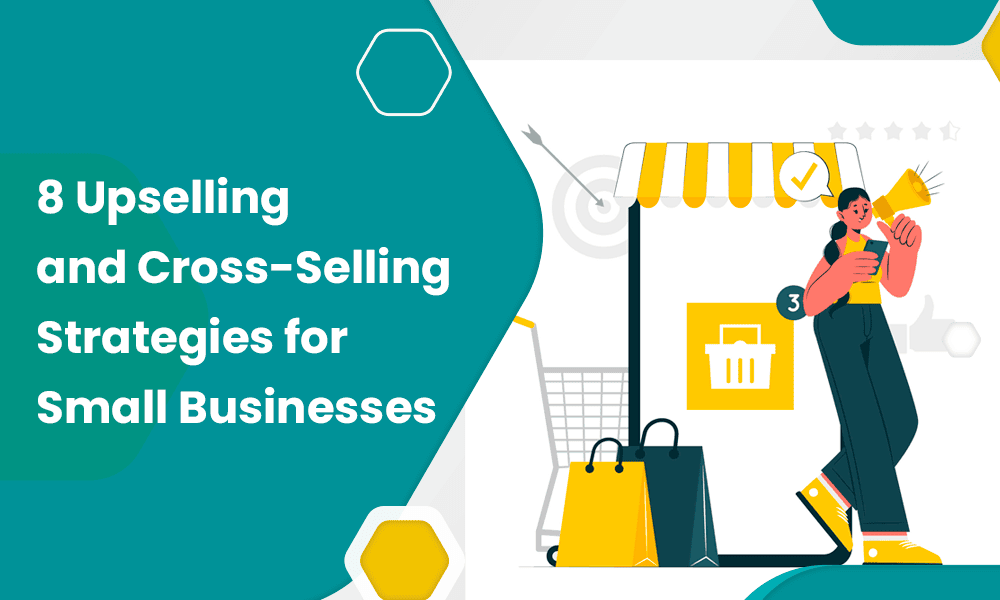In today’s busy world, maximizing revenue from each customer is more important than ever while keeping them happy. Two proven techniques for doing this are upselling and cross-selling.
Remember the last time you were buying a smartphone, and the seller suggested a model with better features? That’s upselling.
Upselling is a sales method where you encourage the buyer to buy a more expensive item, add-on items, or upgrade the existing product.
Whenever you buy flight tickets online, you get several suggestions to add on travel insurance, cab bookings, and even guided tours of your destination. This is an example of cross-selling.
Cross-selling is a sales method where the seller encourages customers to get added or complementary purchases along with the primary purchase item or service.
Both techniques are a win-win solution for customers and small businesses alike. For small businesses, it improves customer retention and the overall customer experience.
A recent study by HubSpot found that upselling alone can increase the average order value by 41%! In another study by Zendesk, over 74% of customers said they are more likely to buy again from a brand if they had a positive cross-selling or upselling experience.
This article will deep dive into upselling and cross-selling strategies, suggest advanced techniques and tools, and explain how to troubleshoot common challenges faced by small businesses in the area.
Table of Contents
Key Takeaways
- Some important psychological triggers and activation techniques for upsells and cross-sells include compound value, scarcity or urgency, prestige and premium, the principle of reciprocity, increased convenience, and incentives.
- Upselling and cross-selling can offer various benefits, such as increased customer lifetime value (CLV), higher profit margins, enhanced customer relationships, and better inventory turnover.
- Some proven strategies for upselling are offering dynamic product comparison charts, creating a tiered pricing model, a bundled pricing model, and a virtual or AI-powered assistant to recommend premium models.
- Companies are increasingly leveraging advanced tools and technologies like personalization with CRM systems, recommendation engines, and data analytics to boost their strategies.
Upselling and Cross-selling: Differences, Triggers, Benefits
Successful small and medium businesses use upselling and cross-selling techniques to maximize revenue and enhance customer experience and retention. So, let’s break down the basics first.
This segment will highlight their key benefits and differences and how you can leverage psychological triggers to employ these sales techniques successfully.
How exactly is upselling different from cross-selling?
Let’s look at what exactly makes these sales techniques different. Once you understand this, you’re well on implementing them effectively.

1. Objectives and sales impact
- Upselling: The primary objective is to convince customers that the extra dollars they’ll spend on a premium item or service are well worth it. For example, Spotify users can upgrade to Spotify Duo for just $3 more and add a friend or relative to their plan. It increases the actual value of the sale.
- Cross-selling: The main objective here is to convince customers that your complementary products will add value or ease and enhance their experience of the primary product or service. For example, a smartphone buyer could also get a protective case or a screen protector for their new phone. It increases the overall value of the sale.
2. Timing
- Upselling: Customers are most responsive to upselling during the initial stage of decision-making, where they are still considering which product or service to buy.
- Cross-selling: Cross-selling is most effective during the initial purchase when they have added the primary product to their cart, and even after they’ve completed the purchase.
3. Customer perception
- Upselling: Customers perceive it as an opportunity to get a better product, features, or better services, even if it is a higher price.
- Cross-selling: Customers perceive it as relevant or helpful suggestions to make their primary purchase easier, more convenient, or complete.
4. Sales strategy
- Upselling: The major sales strategy here is to highlight the value of the premium product or service.
- Cross-selling: The sales strategy here is to showcase complementary products that provide a comprehensive solution to the customers’ needs.
These were some of the major differences. Now, let’s look at how to implement these techniques effectively.
Psychological triggers and their activation techniques
When it comes to these strategies, knowing when to upsell and cross-sell is essential. A powerful approach is trigger-based upselling or cross-selling.
These powerful psychological triggers can convince customers to upgrade at the right time. These triggers or signals can be used during events like customer milestones or when they have just added a product to their cart. Let’s analyze the most effective psychological triggers.
1. A great deal or compound value
Who doesn’t love getting a premium deal, feeling they’ve gained more value than what they’re spending?
However, when the salesperson doesn’t prompt them, customers may not perceive it as a good deal. A good marketer understands customer motivations for buying their product or service. Then, you can easily identify their pain points to suggest complementary products or an upgrade to give them a complete solution.
Consider each suggestion an opportunity to add value and solve customer issues.
Here are some examples to inspire you:
- If you sell sneakers online, stock complementary products like different socks, orthopedic or gel insoles, deodorizing sprays, types of laces, etc. You can suggest prompts like “Get a gel insole for 20% off”.
- If your company offers nutrition or workout plans online, suggest upgrading to a personal coach who offers unlimited calls and guidance for a more premium subscription.
- If you’re a SaaS company, then curating premium bundles within the customer’s budget range is a great option to leverage the psychological trigger of compound value.
2. Scarcity and urgency (or FOMO)
We are all likely to make a different decision when faced with scarcity and lack of time. A recent research paper proved that the more scarce an item is, the more it increases perceived value to the customer.
Regret or anticipation of future regret plays a major role in promoting these purchase decisions. This creates the fear of missing out (or FOMO). After all, what do you think drives those Black Friday sales?
There is a definite satisfaction in purchasing the last item in stock. You can leverage this psychological trigger by highlighting a limited number of units left in stock, a limited-time discount, or last-chance offers. Here’s an excellent example of this technique in action.

3. Prestige and premium
Shoppers don’t just buy for practical reasons. They buy for emotional reasons too. Sometimes a premium offering at a higher price can cater to the prestige factor or the ego factor.
The goal here is to increase the perceived exclusivity and quality factor in the eyes of customers. It also enhances your profit margin while improving brand loyalty. This is one of the key reasons people prefer to purchase an iPhone over an Android.
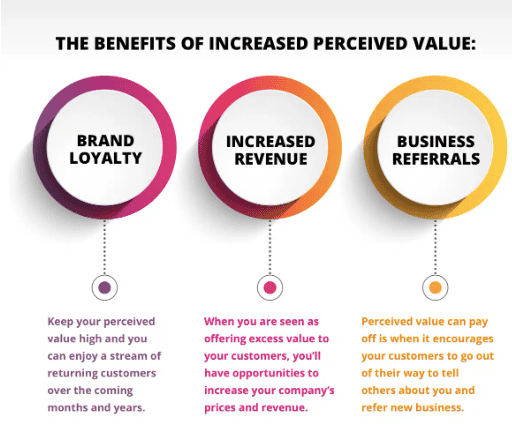
Even if your store sells cost-effective products, adding one premium product to your mix can give you an increased perceived value in the eyes of customers.
Here’s how Apple leverages this trigger: Apple encourages its customers to trade old devices for new ones. Apple also recycles its products for free, which is a win-win solution for the company, its customers, and the planet.

If customers aren’t yet sure of the new product, they can convert it into Apple gift cards for future purchases. This ensures that customers keep coming back to them for future purchases and boosts brand loyalty.
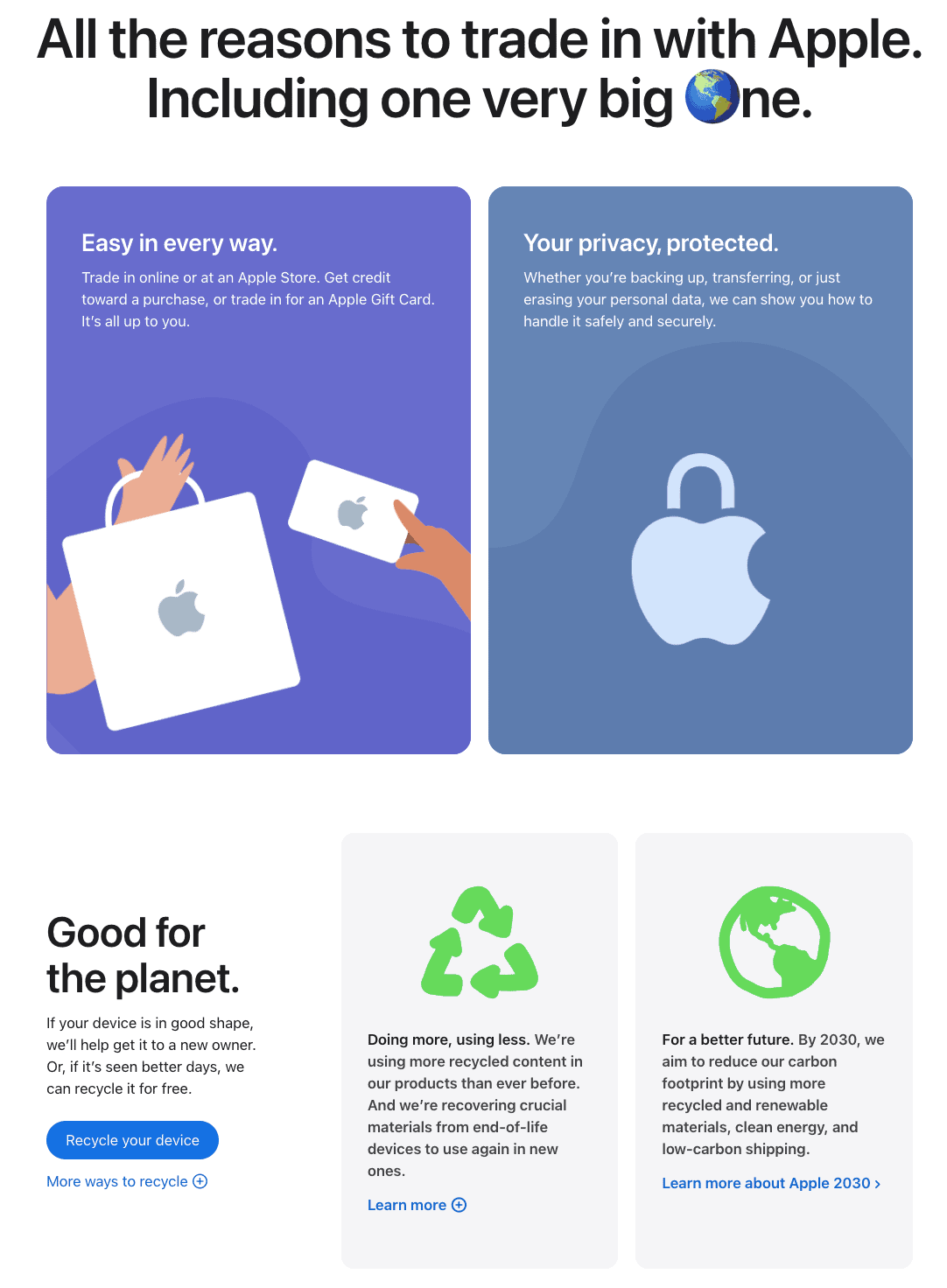
4. Reciprocity
How do you feel when a new burger joint offers you a free slider or fries with your first order? You are more likely to feel warm towards the burger joint in the future, right? This is known as the reciprocity principle.
Here’s an interesting experiment by Philip Kunz, a sociologist at Brigham Young University. He selected 600 strangers at random and sent personal, warm Christmas greeting cards to them and aimed to observe their responses. He found that well over 200 strangers sent him a card back and many of them sent back long handwritten letters thanking him.
In marketing, companies leverage this principle to invoke a mild sense of indebtedness in their prospective customers. In principle, it also builds a warm relationship with prospects. Here’s how you can utilize this principle:
- Offer a tangible benefit to customers without focusing too much on the results, especially if you’re a new company.
- The benefit should make the prospect feel valued and understood.
- Try to offer a benefit that makes you stand out like hosting a community event, personalized outreach, or personalized free samples.
- Proactively nurture the relationship once you’ve offered a benefit.
Here’s a great example from the razor store Harry’s.

5. Convenience
Time is one of the most precious commodities for each customer. So, one way to trigger an increase in your upsells and cross-sells is to sell them convenience. Customers are usually willing to pay a bit extra for convenience. This is why apps like Uber have become so hugely successful.
Of course, you have to first offer a smooth and seamless shopping experience before capitalizing on this trend. Consider offering a subscription program where customers won’t have to place a fresh order each month for their supplies. Here’s an excellent example.
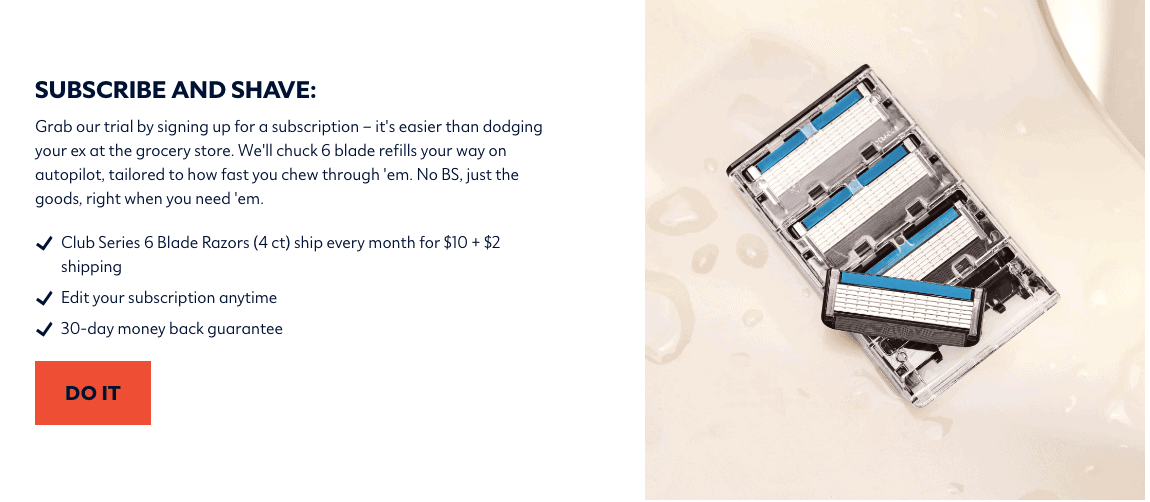
6. Incentives
What do we mean by incentives in this context? It’s quite simple, actually. Whenever a prospect is browsing your products, offer them an added incentive like free shipping, buy two get one free, and similar offers.
This way, even when your prospects may have planned to buy one item, there’s a higher likelihood of them buying more to claim the incentive. Recent studies have proven that 91% of customers would purchase more if they found the right add-on product or incentive.
Several eCommerce websites already offer free shipping once the order value crosses a particular threshold. Here’s a standard incentive. But, try to get creative and stand out even more to consumers, as they’re used to these kinds of incentives.

Now that you’re ready to leverage these tried and tested psychological triggers, let’s look at the benefits you gain from employing them in your cross-selling and upselling strategies.
What are the benefits of upselling and cross-selling?
Both upselling and cross-selling give you added income from the increase in order values. That’s the bottom line.
Here are some more added benefits.
- Increased customer lifetime value (CLV): Both techniques enhance CLV by encouraging higher spending over the lifetime.
- Enhanced customer relationships: Personalized product recommendations and upgrades make customers feel valued and understood. This promotes customer loyalty and satisfaction.
- Increased revenue and sales volume: Upselling and cross-selling increase the value of each order whether it’s by a premium upgrade or by sales of complementary products.
- Enhanced inventory turnover: With these techniques, you reduce the likelihood of leftover stocks and keep a healthy turnover.
- Higher profit margins: Upselling in particular contributes to higher profit margins as you’re able to sell more premium products or services to boost the profitability of each sale.
- Competitive advantage in a saturated market: No matter your niche, these techniques can help differentiate your business from your competitors and stay ahead of the curve.
- Optimal data gathering and utilization: You’ll need to gather customer history and behavior data to give personalized recommendations. This will help you make data-driven marketing and sales decisions at the right time.

So, there’s not a lot you stand to lose by implementing upselling and cross-selling for your business. Let’s deep dive into some proven strategies that can help you glean all these benefits.
4 Key Strategies for Effective Upselling
Upselling is an important sales technique to boost the average order value and customer satisfaction. We’ve curated a list of proven upselling strategies that work. And, we’ve added a bonus out-of-the-box idea for those who want that extra splash of creativity for their small business. Let’s go!
Identify the right opportunities
When it comes to upselling, any strategy will fall flat on its face if you’re not able to identify the right opportunities and the right contexts.
Clarity on your target audience, their purchase, and behavior history is crucial here. Once you gather this data, segment your audience based on buyer personas, demographics, spending history, and buying habits. But, this remains incomplete without understanding your product mix.
Get clear on your top-rated products with the highest demand before identifying how you can upsell or cross-sell complementary products with them. List out the unique features of your products and what makes your products unique in the tightly saturated market.
Once you have all this data, leverage it to personalize your product recommendations based on the customer journey map. Here, identify products that aren’t performing well and figure out what incentives will sell to your customers. As always, keep analyzing your data with a reliable CRM system like EngageBay and keep improving this process.
But it’s not enough to offer prompts and add-on options on your website. Use these upselling strategies to make the most of each order placed.
1. Offer product comparisons
eCommerce is a dynamic industry. Your prospects have access to thousands of products in your niche with the click of a button. So, product comparison can be an effective way to upsell products with better features without being pushy.
Here, we don’t mean a simple chart laying out the features of different products. Rather, it needs to be user-friendly and enhance the overall customer experience. Make your product comparison chart easy to find and navigate. Here are some more tips:
- Present customers with similar products but with slightly better features.
- Highlight key features based on the pain points for each segment of your audience.
- Use visual cues and aids to delineate the premium version from the basic version, with an emphasis on the added benefits of the premium version.
- Implement a dynamic product comparison chart that gives users the option to filter features.
- Use AI-based analytics to create dynamic comparison charts based on demand for a product and customer behavior history.
2. Consider bundle offers
Bundling complimentary premium products and offering them at a discounted price is another proven upselling technique. Let’s say your customers are searching for athletic wear. Here, you can create a bundle for a “marathon wear” bundle offering sweat-proof athletic wear, a towel, and a free water bottle based on user history and interests.
It’s a great way to sell items that may be less in demand, too.
Here are some ways to bundle products.
- Seasonal bundling: Capitalize on the holiday seasons with themed bundling. Offer a premium product or complementary products that are gift-worthy.
- Tiered bundling: Create a tied bundling, ranging from the basic to premium versions of your products. This ensures that every customer finds something of value, no matter their budget.
- Gamify the bundling experience using “DIY Bundling”: Once customers select the products, gamify their experience by giving them a few design options to choose from. This enhances customer satisfaction, especially if they are gifting the products.
Here’s a great example from Kylie Cosmetics: “Kylie’s Lip Favorites Bundle.” They offer a variety of handpicked bundles with limited-time online discounts.

3. Offer tiered pricing models
This is a key upselling technique if you offer services. A tiered pricing model is a customer-centric flexible pricing approach. For example, a SaaS company can define tiers based on the number of users and premium features on offer.
Each tier is then priced differently and billed monthly.

If you offer subscriptions, then you can utilize this strategy beyond the SaaS industry, too. Here are a few different types of tiered pricing models to consider.
- Three-tiered model: Here, you offer three tiers of pricing, usually basic, medium, and premium. The tiers can be set based on user requirements or features. Most people are already familiar with this model as it is the most common.
- Feature-based tiers: In this model, you offer three or more tiers of pricing based on the features. With each tier, the user gets more premium features and convenience.
- Usage-based tiers: This model is commonly used by internet and communications providers but can be extrapolated to other niches as well. Here, clients pay based on their monthly usage limits. You can charge an overhead if they exceed the usage limit for a month.
Here’s a great example of Zapier’s tiered model and how they leveraged social media to communicate changes in their pricing strategies when it wasn’t working.
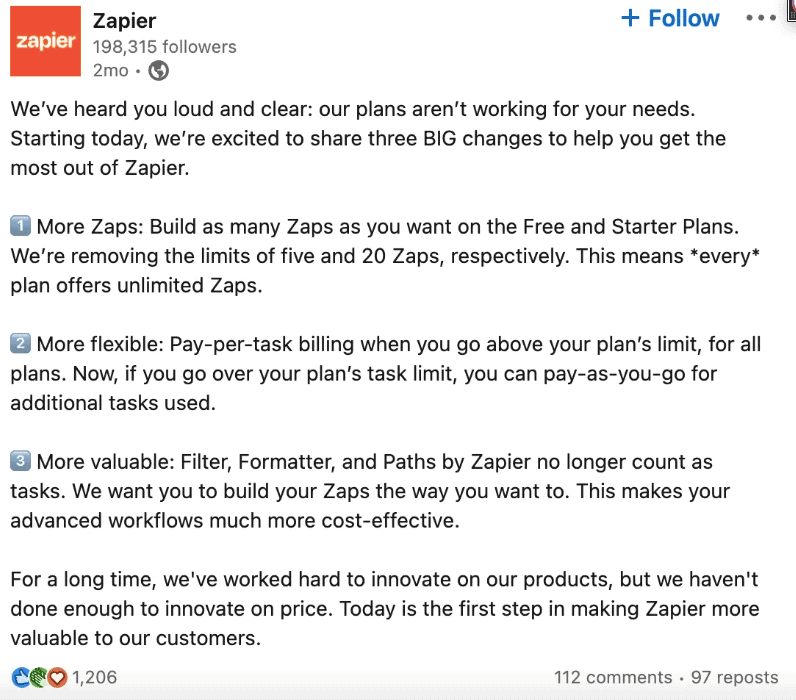
4. Bonus idea: Complementary virtual shopping assistant
Here’s another upselling technique worth a shot if you’re looking for more creative ideas. Today, customers expect personalization more than ever before. To leverage this trend, offer a complementary virtual shopping assistant to help your customers find exactly what they’re looking for and to suggest premium products.
When a customer browses your website, create hype by offering the option of booking a free virtual consultation with a digital shopping assistant.
Alternatively, you can offer quizzes to help customers find the perfect item if a virtual consultation would prove too large for your budget. With new AI integration options, you can improve conversational capacities and find the right products for customers. The key is to ask the right questions and get premium recommendations out to customers.
Here’s an example of the “Parts Finder Assistant” from Ingersoll Rand that helps customers choose compressor parts:
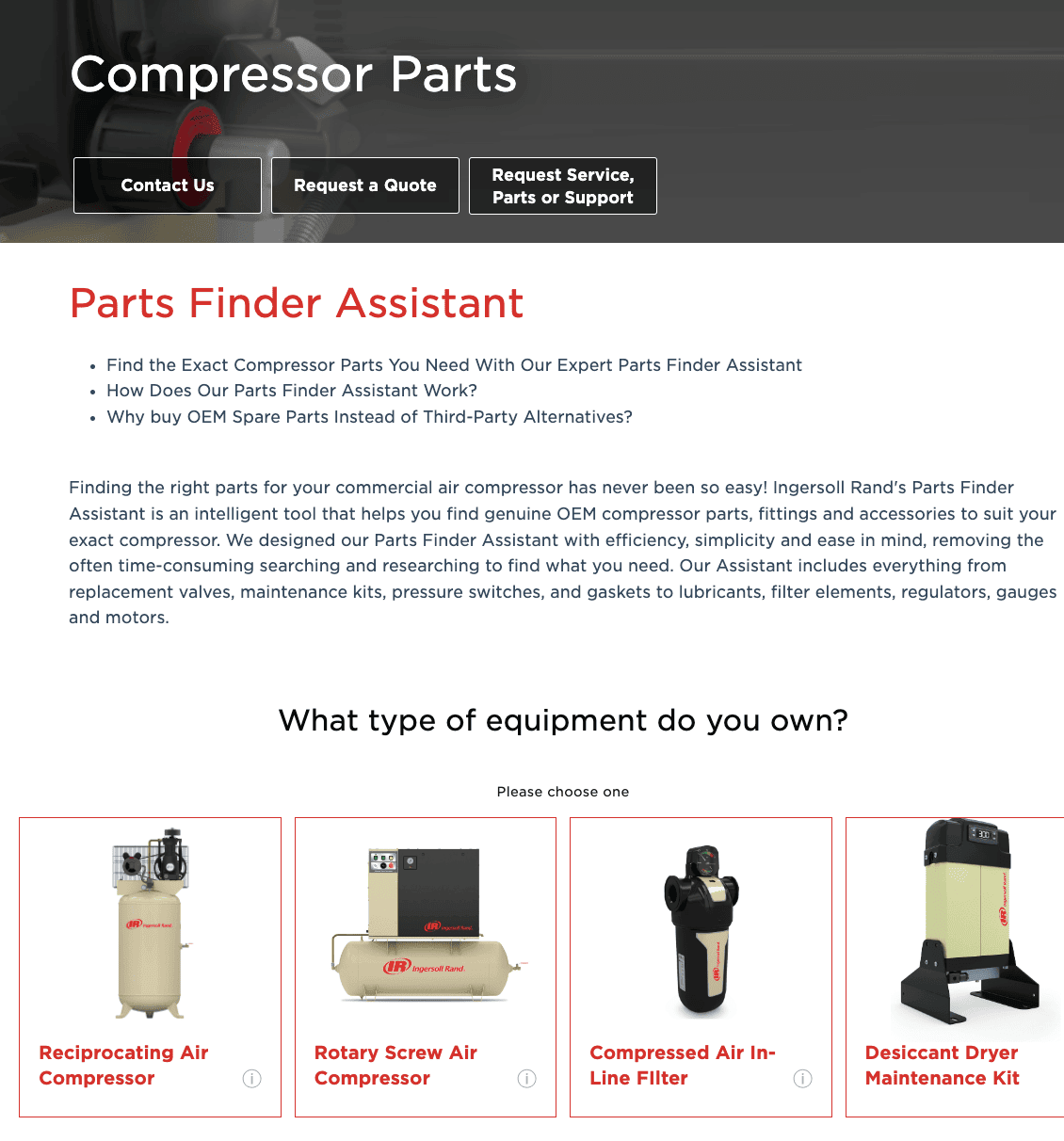
Read more: How To Upsell Using Email Marketing to Increase Revenue
4 Proven Strategies for Effective Cross-selling
Here are some proven strategies to get you selling more complementary products like a pro and adding to your overall sales volume. There’s also a bonus out-of-the-box idea for those of you wanting that extra flair.
Let’s dive in.
1. Add-ons and complementary product recommendations
Whether you have a brick-and-mortar store or an online one, this cross-selling technique is sure to work. It’s also one of the most straightforward techniques.
Here, you provide the right add-ons or complementary products that will enhance the customer’s experience of the primary product. For example, if you’re selling TVs, a speaker or a surround sound system could be your add-on product.
Alternatively, you can suggest add-on services that align with the customer’s purchase. For example, a TV seller could offer add-on product cleaning and servicing for the first year.
Here’s an example. This company runs a pop-up recommendation for complementary products whenever someone adds a product to their cart.
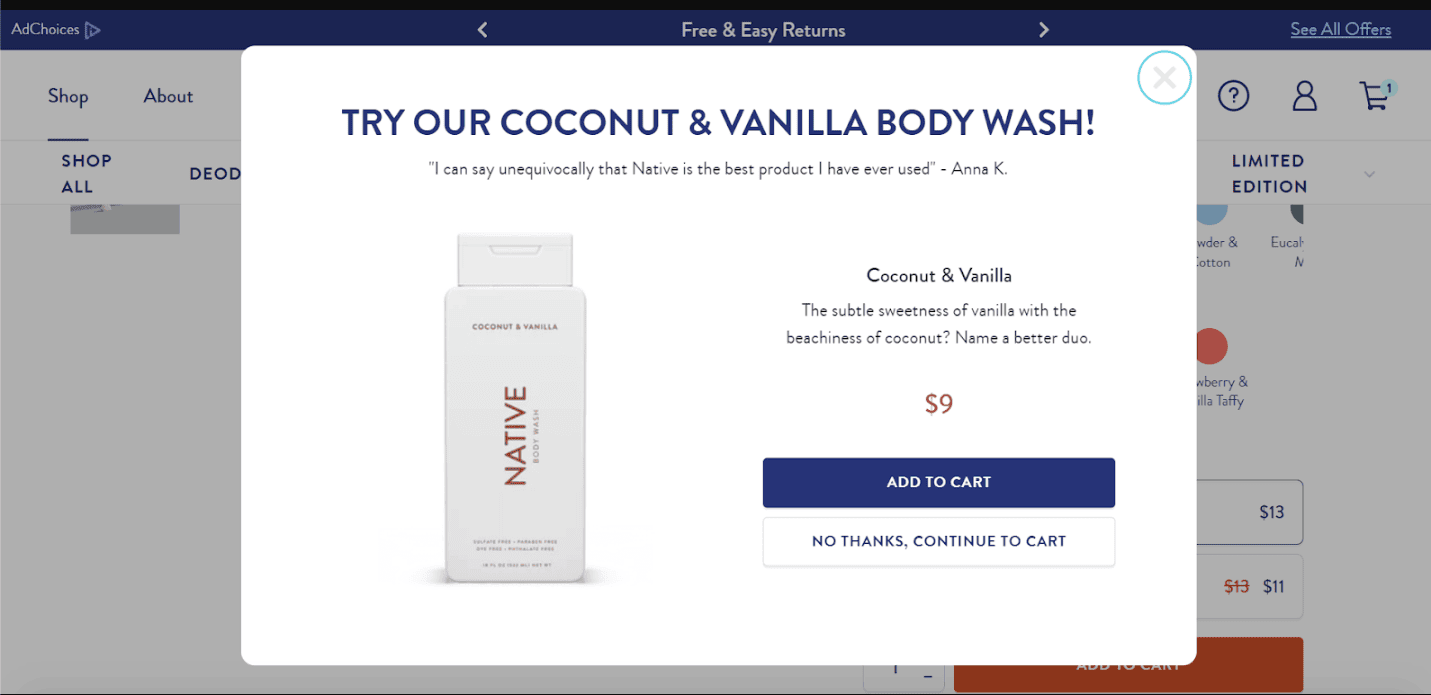
2. Frequently bought together options
This is similar to the complementary product recommendations, but it provides more options to the customer. Amazon is an expert at this cross-selling strategy.
By leveraging the customer’s purchase history, interests, and budget, you can give them a nudge toward purchasing more from your brand. When you browse a neck pillow on Amazon, you’ll get a recommendation for an eye mask or an under-eye gel.
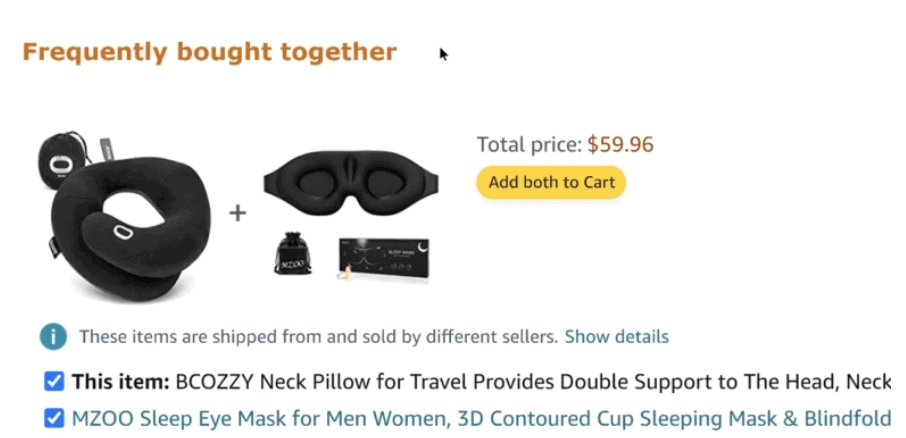
3. Post-purchase recommendations through SMS or email
Your cross-selling strategies don’t stop when the customer buys a product. Post-purchase is a great time to suggest recommendations through SMS or email.
When you send out your thank-you email, add a few cross-sell recommendations based on their purchase history. Or, send out a well-timed SMS offering a limited-time discount for purchasing complementary products with your brand.
Here’s a great email example of cross-selling done right.
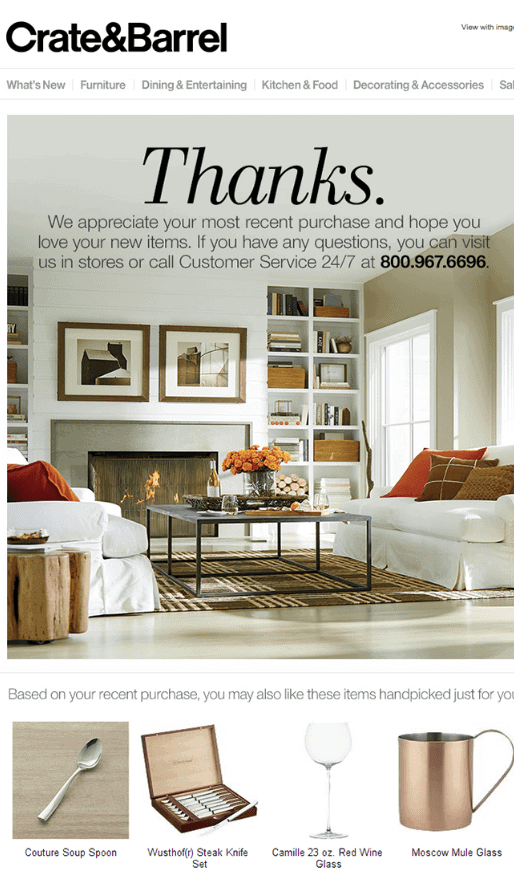
4. Bonus idea: Themed post-purchase subscription boxes
Who doesn’t love getting curated subscription boxes in the mail with goodies that are curated just for them? Leverage this aspect of human psychology by offering themed subscription boxes with complementary products.
Let’s say you’ve sold a pair of runner shoes. Send an email with an offer for a “Runner’s Monthly Subscription Box” with curated complementary products like moisture-absorbant socks, energy bars, a resistance band, or a runner’s water bottle.
You can also add complementary monthly discount coupons for future purchases, and brochures on various aspects of running like endurance, recovery, and health.
Nike already has such a subscription box with the option to get new shoes every few months or so.

Now that we’ve looked at some upselling and cross-selling strategies and techniques, let’s dive into some advanced techniques and tools you can leverage to take any of these strategies further.
Read more: Cross-selling Guide for Beginners (With Examples & Strategy)
Leverage Advanced Techniques and Tools to Boost Revenue
When it comes to techniques that can enhance your upselling and cross-selling strategies, personalization is one of the most important.
Personalization and data analytics
Personalization in marketing is about curating a tailored, unique shopping experience and segmenting customers based on preferences, history, and demographics. Here, data analytics and AI-driven data insights can help you stay ahead.
First, you’ll need to segment your customer base based on demographics and purchase history. Data analytics can also give you a predictive model to help you cater to user demands when they’re likely to arise.
Predictive modeling uses past behavior to predict future customer behavior. It also helps provide relevant and valuable products for upsells and cross-sells to enhance the overall customer experience.
You can leverage data to refine and discover new opportunities for cross-sells and upsells, avoid human errors, and nip potential barriers in the bud.
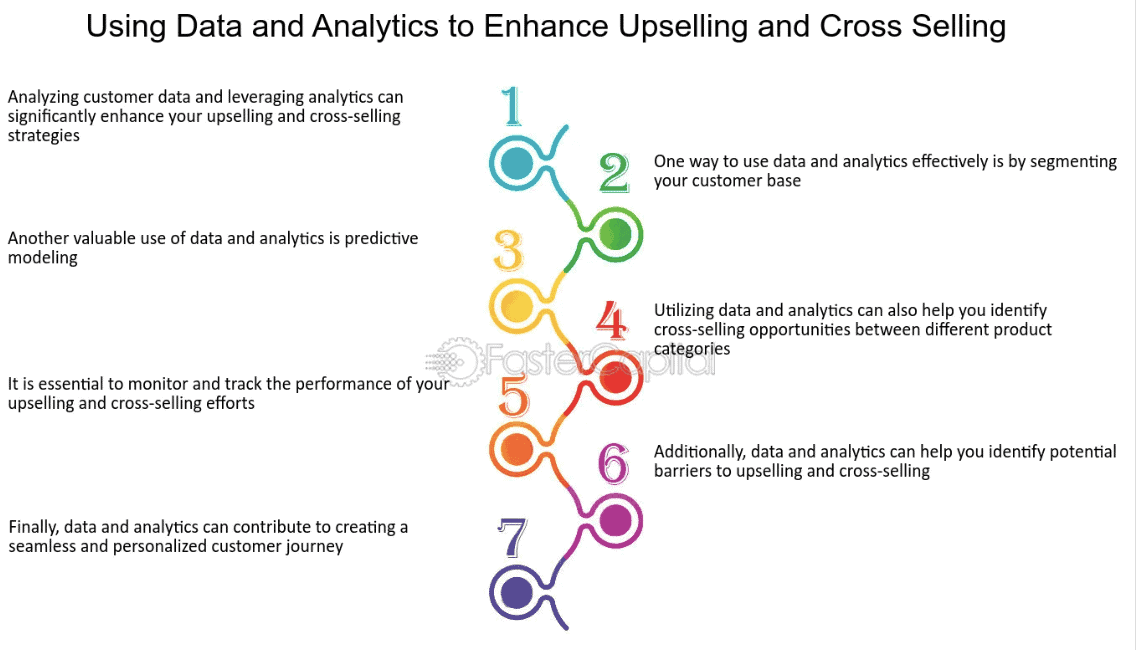
Data analytics can also help you with marketing on various channels like email, social media, and YouTube. For instance, you can leverage analytics to generate dynamic content for post-purchase cross-sell emails. Here, the content of your email changes based on customer preferences and history.
Finally, data analytics will help you glean accurate insights from your upselling and cross-selling strategies and give you the tools to make real-time changes to your strategy.
Leveraging the best technology
In this dynamic market, it’s nearly impossible to stay relevant without the right technologies to help you. Most companies already take a digital-first approach, so why should you miss out?
Here are some technologies to help you stay ahead of the curve.
CRM systems
A Customer Relationship Management (CRM) system could be a game-changer if you don’t already have one. It makes data collection and accessing customer information a piece of cake.
A CRM solution like EngageBay’s all-in-one platform can help you:
- Gather and segment customer information in one unified platform.
- Analyze the data gathered across various channels like email, website, and social media in one place.
- Consistently engage customers and visitors across different channels and cater to their needs.
- Monitor the success of your upselling and cross-selling strategies in real-time.
- Use the system to research your industry or niche and find useful case studies to improve your strategies.
Read more: Operational CRM — A Complete Guide (+7 Best Operational CRM Software)
Recommendation engines
A recommendation engine or a recommendation system is like a smooth, tech-savvy salesperson who can leverage customer data and upselling and cross-selling strategies to show the best product recommendations to your customers.
Amazon has one of the best recommendation engines in the retail world today. So, if you order a fiction book, you’ll get lots more recommendations in the same genre in the blink of an eye.
Many recommendation engines also make use of machine learning algorithms to generate insights and give better recommendations that would be suited to the customer’s tastes and preferences.
Automated marketing tools
Upsell and cross-sell automation tools are a great asset for any small business to solidify its sales and revenue.
Automated marketing tools for upselling and cross-selling work by using algorithms and data analysis to predict customer behavior and recommend the perfect products.
By automating your upsell and cross-sell strategies, you can reduce the likelihood of human errors and save significant time.
Tinuiti’s 50% revenue spike from cross-selling: A case study
Tinuiti is a popular independent marketing firm based in the US. They faced a major hurdle in implementing their cross-selling strategy — a manual sales system with no data analytics and automation. As the company started scaling up, it became harder to see results from cross-selling.
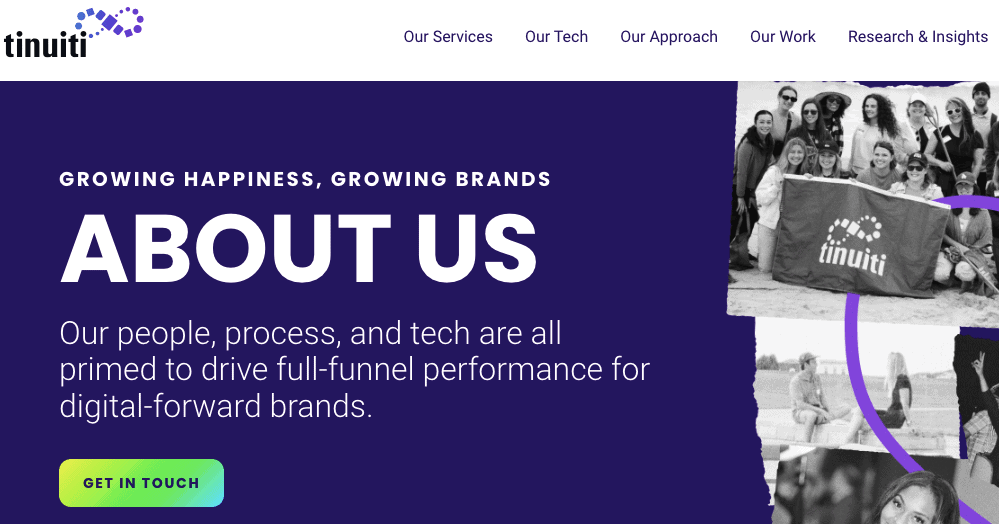
So, Tinuiti leveraged a tool to automate and track keywords mentioned in sales and client conversations in cross-sell opportunities. They also tracked keywords that indicated a lower customer satisfaction score.
With automation and data analytics, they saw a 50% increase in year-on-year revenue from cross-sells compared to the previous year. This is a great example of how the right data and analytics can significantly boost your campaigns.
Common Upsell and Cross-sell Challenges and Overcoming Them
A smooth sea never made a great sailor. You’re likely to face some challenges on your upselling and cross-selling journey. Here’s a list of the most prominent ones and tips on overcoming them.
1. Overcoming customer resistance
One of the top challenges for small businesses is customer resistance to upsells and cross-sells. When a customer perceives upsells and cross-sells as irrelevant or (god forbid) pushy, the business suffers.
A pushy sales tactic can have the opposite effect. Customers are likely to have a negative experience, which means there is a lower chance of repeat purchases.
How do you solve this issue? The answer lies in personalization and relevance. Never suggest products or upgrades that are likely irrelevant or too expensive.
Offering personalized product recommendations ensures that prospects find genuine value in your suggestions. Building trust and credibility is another key focus area to avoid this pitfall.
Build your brand around your values and showcase plenty of social proof as you highlight product benefits. For the best results, we suggest creating discrete customer missions for different customer segments.
2. Balancing customer satisfaction and profitability
Another common challenge faced by small businesses is finding that fine balance between customer satisfaction and profitability. Swing too hard either way and you’re sure to lose out.
Here, the key lies in not being pushy or aggressive with your sales tactics. Avoid these pitfalls and you’re golden.
- Don’t over-promise and under-deliver on any deal. Be upfront and set appropriate expectations at the outset.
- Equip your team with the right information to deal with customer queries and concerns. Over 80% of customers report lower customer satisfaction when a brand cannot answer their questions appropriately.
- Don’t give customers a reason to doubt your credibility or judgment.
- Regularly run tests and monitor your strategies to ensure they add value to the customer and they don’t feel pressured.
3. Leveraging customer data
Many small businesses, especially new ones, struggle with gathering customer data. Alternatively, you may have your data but struggle to analyze it and glean the right insights.
The only way to overcome this challenge is to invest in the right data collection tools to gather all the information you need across various touchpoints in one location. A CRM system like EngageBay would be helpful in this area and help you make data-driven decisions at the right time.
4. Finding the right timing and product mix
This is another common pitfall that many small businesses face. To overcome this, never recommend too many products for upselling or cross-selling.
This is called the “paradox of choice,” where too many choices tend to paralyze the decision-making process. Instead, help customers by narrowing down their options to the most feasible and valuable ones.
The right timing is equally important. Even the right product recommended at the wrong time might damage customer relationships. For example, recommending an expensive upgrade when your client is in a financial crunch comes across as tone-deaf and doesn’t take their needs and limitations into account.
So, ensure that your customer’s needs, preferences, tastes, and situation are at the forefront of your upselling and cross-selling strategy.
Conclusion
We hope this article inspired you to nurture your upselling and cross-selling strategy. Constant innovation and troubleshooting can help you win customer loyalty and increase profitability.
After all, businesses have a 60-70% higher chance of getting sales from existing customers over sales from new customers. The strategies suggested here will also help you improve the overall customer lifetime value (CLV) in the long run.
Let us know what strategy inspired you the most and how you plan to implement it in the comments below!
FAQ
What are the best practices for upselling without being intrusive?
Here’s how you can upsell without being intrusive:
- Recommend the right and relevant products
- Ensure the recommended products enhance customer experience.
- Offer what customers would want — even when they may not know they want it. Product comparison is key to convincing them.
- Offer incentives like free shipping and limited-time discounts to create urgency.
How can I measure the success of my upselling and cross-selling efforts?
Measure the success of your upselling and cross-selling efforts with these simple steps:
- Set clearly defined and measurable goals from the outset. These goals should align with your marketing and business goals.
- Choose the right mix of metrics based on your goals. This could include KPIs like Average Order Value (AOV), Customer Lifetime Value (CLV), Customer Satisfaction (CSAT), and Net Promoter Score (NPS).
- Choose the right tools and CRM system to gather data and real-time analytics. Once you get the analytics, work on improving each chosen metric through implementing better upselling and cross-selling strategies.
Are there specific industries or sectors where upselling/cross-selling is more effective?
Upselling and cross-selling strategies can be effective across industries and sectors. But, they tend to be most effective in industries that rely on repeat purchases, complementary products, and premium features or products. Upselling and cross-selling strategies have a proven success rate in industries like:
- eCommerce and retail
- Electronics
- Technology systems
- Hospitality and travel
- Food and beverage
- Health and wellness
- Automotives
- Finance and financial services
- Telecommunications
- Home improvement and furniture
How can I train my team to effectively upsell and cross-sell?
Here’s how you can equip your team to effectively upsell and cross-sell your products to increase sales volume and build customer loyalty:
- Deep product knowledge: Provide your team with the right data and manuals on your products and services, including features, pricing strategies, benefits, and differences between basic and premium features.
- Customer-centric upsell and cross-sell approach: Train your team to highlight the benefits of your products from the customer’s point of view. Target customer pain points and provide practical solutions for them.
- Leverage data and tools: Your team should be skilled in handling tools like CRM systems or OMS systems and leverage real-time data analytics to make the best pitches at the right time.
- Incentives and regular training: Provide the right incentives to motivate and engage your sales team. Regular training sessions will help them stay updated on the latest trends and strategies that can be implemented in their upselling and cross-selling tactics.
- Positive and encouraging sales culture: Ensure a positive sales culture where team members learn from each other. Utilize case studies and success stories to motivate the team regularly.
